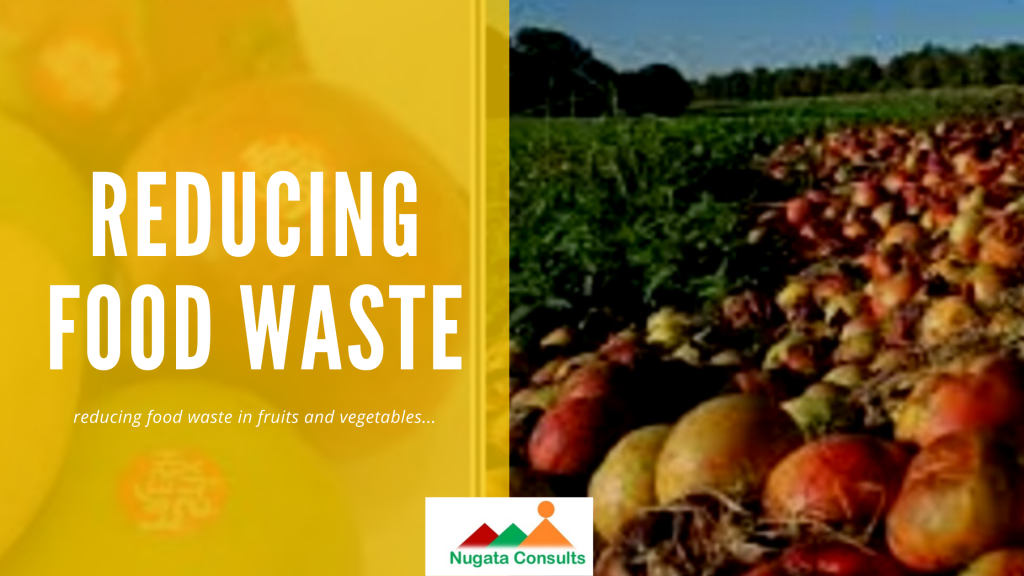COURSE 11 OF EXPORT MANAGEMENT PROGRAM BY FIDELITY BANK, LBS AND NEPC
October 18, 2021Amendments to EU plant health rules for False Codling Moth
March 1, 2022
About one-third of food produced globally for human consumption is lost or wasted every year
according to FAO.
Food loss occurs on the farm before food reaches the consumer while food waste occurs at the
retail and consumer end of the food chain. The part of food that is lost from harvest up to, but
not including, the retail level is called food loss. The part wasted at the consumer or retail level
is referred to as food waste and is mainly associated with the behavior of retailers, the foodservice sector and consumers. This distinction is important to address the root causes of this
problem that everyone from farmers/producers to processors, retailers and consumers can help
end.
At the farm level, Good Agricultural Practices (GAP) that include proper handling and
processing would reduce food waste.
At the retail level, food waste can also be reduced by proper handling and good storage
conditions. Retail stores may also have for sale, fruits and vegetables such as apples, papaya,
dragon fruit, avocados, star fruit and pears that have had their shelf life extended by the use of
“special” stickers, one to a piece of fruit. The stickers are coated with a mixture of sodium
chloride and beeswax, which slows down the fruit ripening process by removing ethylene—the
ripening hormone in fresh produce from the air around the produce. The sticker uses 100 %
natural ingredients to keep the fruit looking and tasting farm fresh for up to 14 days or longer
and acts in the same way as the natural protections used by plants themselves.
Consumers do not have control over food loss during production, processing and in the
marketplace but can be meticulous and help reduce food waste by taking proper care of fruits
and vegetables from the point of purchase to consumption. By doing so, they can save money,
be able to feed hungry individuals and play a positive role in reducing food waste. This will lead
to a reduction in landfill use and the corresponding methane emissions (global warming).
Consumers can contribute to reducing food waste by changing their habits. This can be
achieved by doing the following:
1. Buying Fruits and Vegetables Sensibly
- Shop at farmers markets early because the heat of the day can alter fresh produce
quality or hasten ripening. - If you are buying from a grocery store, purchase fresh produce towards the end of your
shopping to maintain its freshness. - Buy just the quantity you need since fresh produce has a limited shelf life.
- Fresh produce imperfections may be acceptable, but avoid fruit or vegetables that are
overly bruised or damaged.
2. Storing Fresh Produce Correctly
- Store perishable fresh produce in a clean refrigerator. If produce is refrigerated at a
grocery store, it generally should be refrigerated at home to maintain quality. - Store fruits that produce large amounts of ethylene gas while ripening away from other
produce. Such fruits include avocados, unripe bananas, nectarines, peaches, tomatoes,
apples, apricots, cantaloupe, figs, kiwis and plums. They can ripen other produce when
stored together. - Use produce with a short shelf-life e.g. fruits such as apricots, blackberries, raspberries
and strawberries and vegetables such as herbs, sprouts, corn, cucumbers, eggplant,
green beans, leafy greens, lima beans, mushrooms, peas and summer squash within a
couple of days of purchase. - Fresh produce with a longer shelf-life can be consumed after most of the other fruits and
vegetables. This includes apples, pears, beets, carrots, garlic, onions and potatoes.
Eating foods with a short shelf life first can be helpful in reducing food waste.
3. Preparing Fruits and Vegetables Cleverly
- Wash the entire fruit or vegetable properly. Cut off any bruises and blemishes
- Prepare only what you need, to avoid food waste
- Make your own frozen food from any leftovers. Cut fruit and blanch vegetables before
placing in air-tight containers for freezing. Blanch vegetables before freezing to help slow
down the spoilage and to preserve the color and texture. - Be creative with produce at the end of its edible life. Puree fruits into smoothies or sauté
cut up vegetables and serve with rice, fried plantain or any meal of choice.
4. Composting Left Overs
- Put to use leftover fruits and vegetables by composting them. This will help reduce
methane emissions in landfills and significantly contribute to your reducing food waste.

1 Comment
Well written Jane. Just to add my bit, you left out the aggregator/wholesaler/transporter handling and treatment as a critical contributor to losses and waste. No reversal can occur with physically damaged and contaminated food no matter how well it left the farm or the retailer or consumer attempts to slow down spoilage. The chain is only as strong as the weakest link. All links, like in a relay, cannot afford to drop the baton.
Another dimension is capacity. Supply systems synchronisation for optimisation implies planning. No system will give 100% but properly working with reality helps as does a large dose of expertise and creativity. Thank you for the short piece.